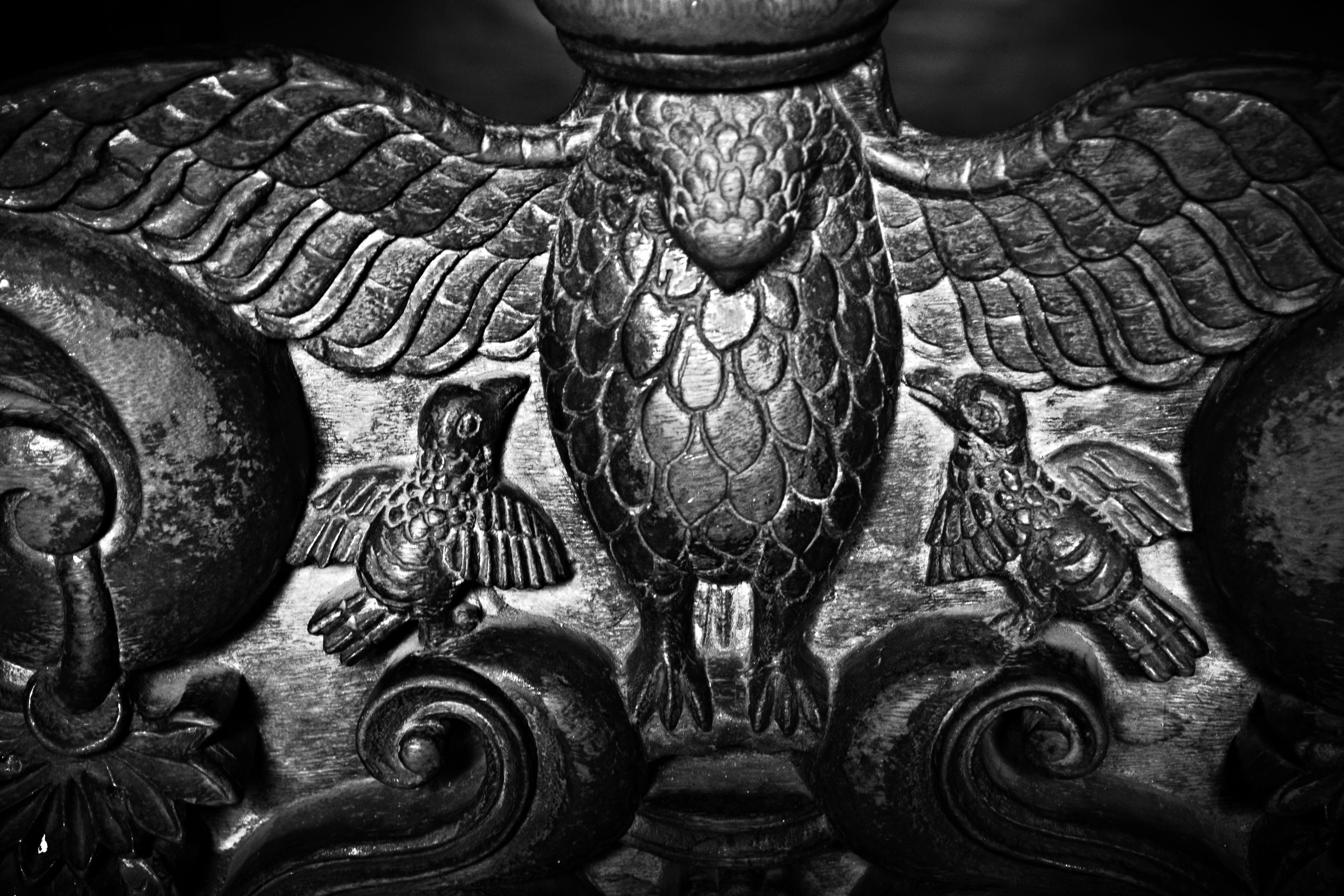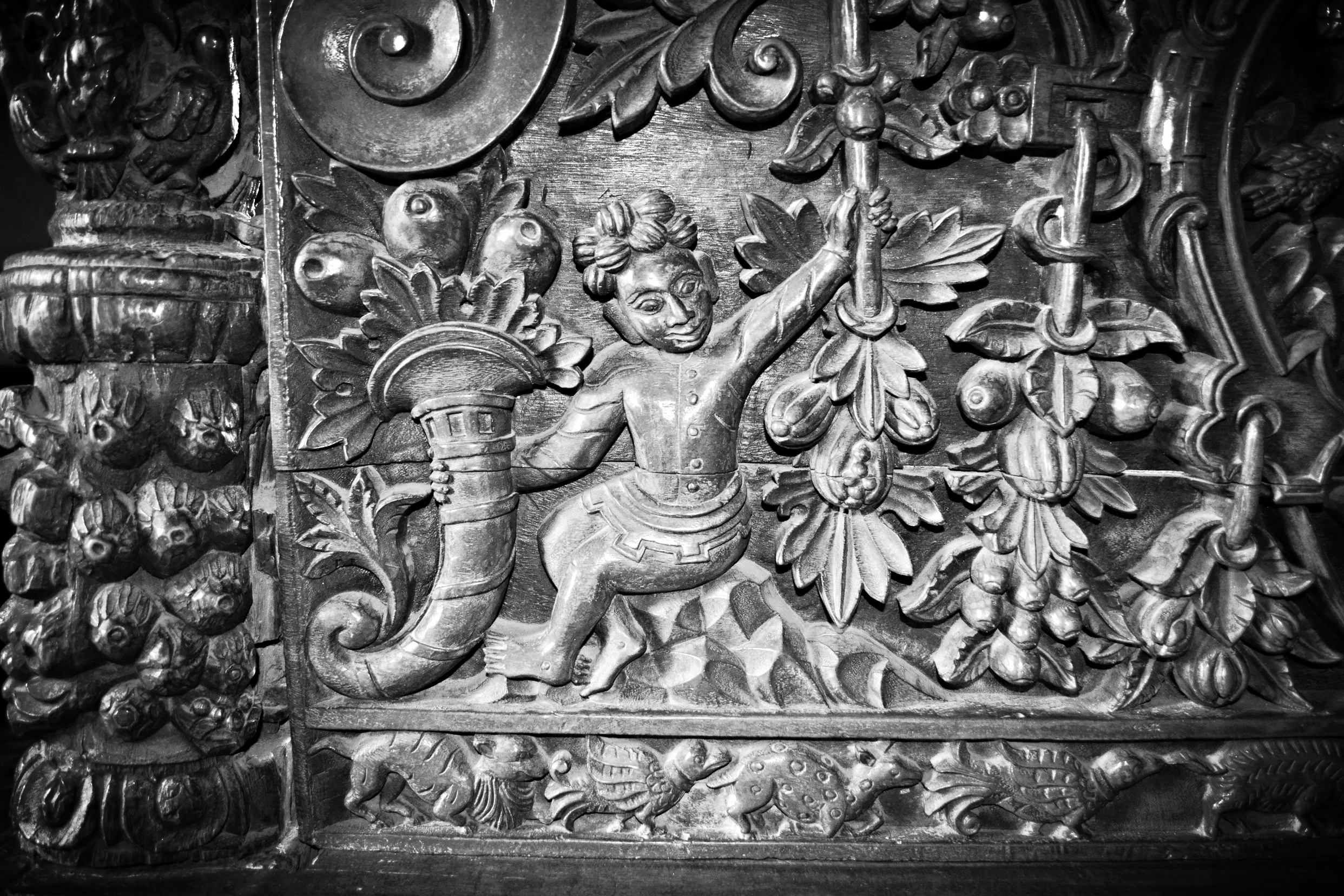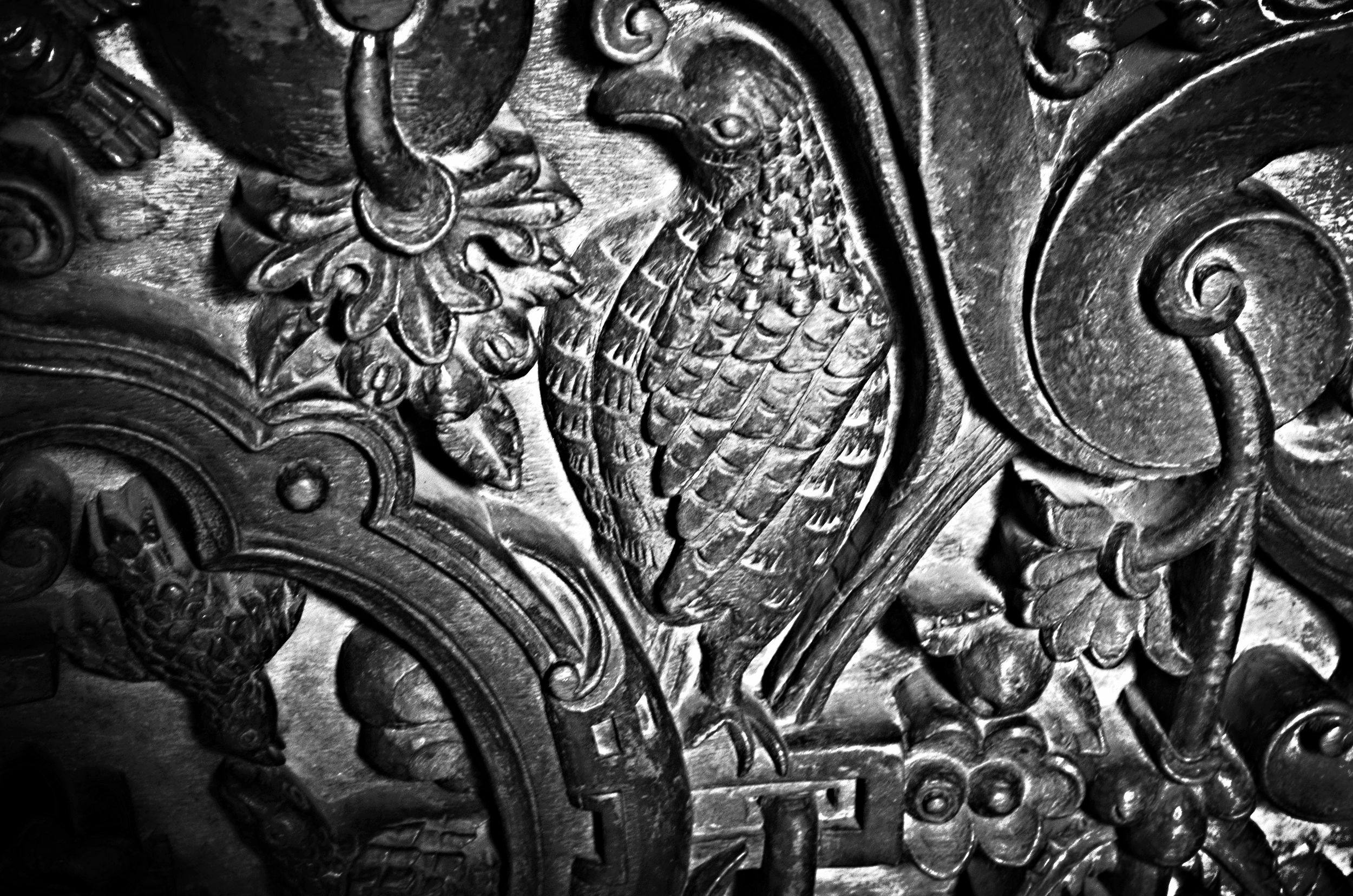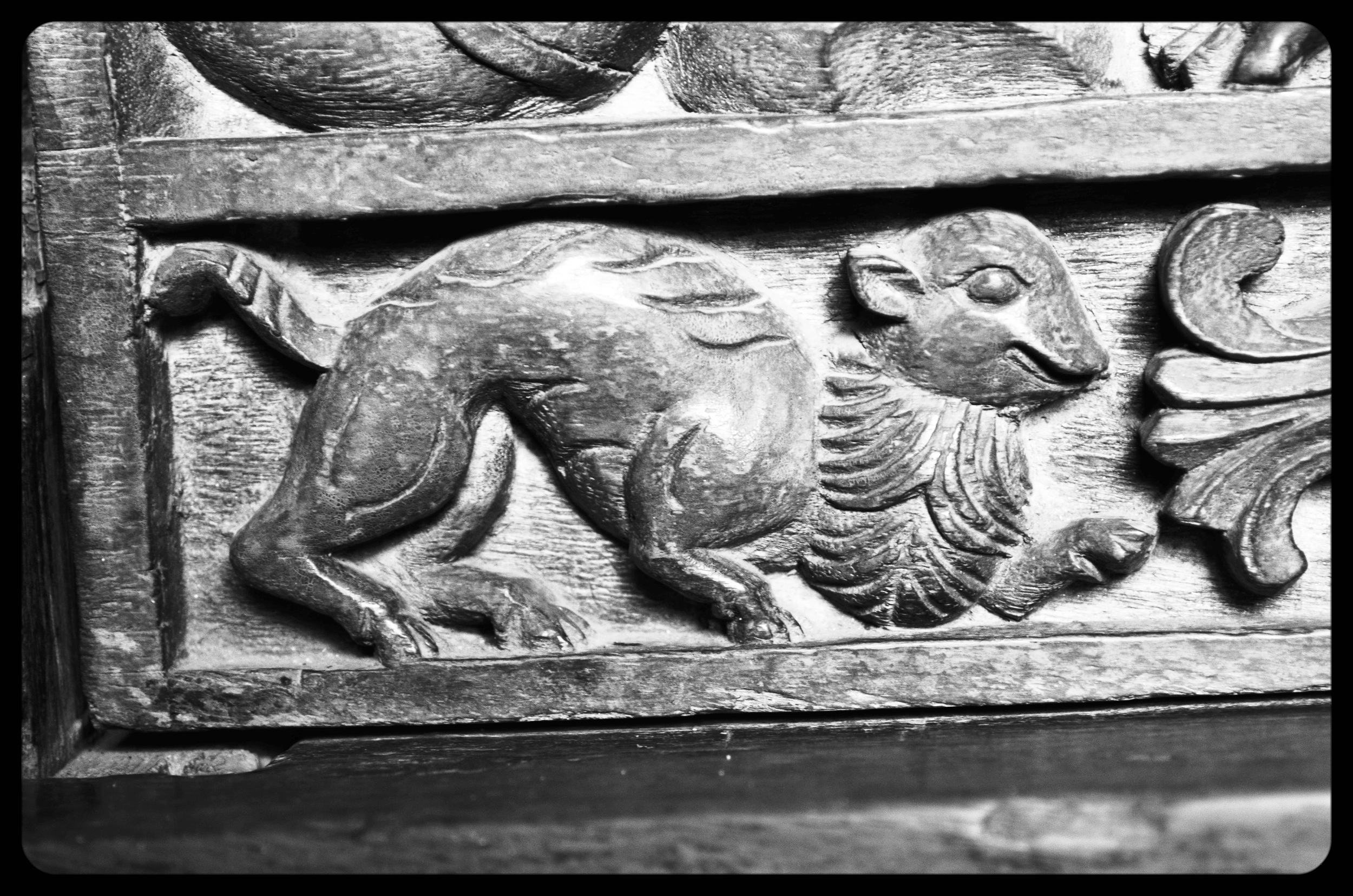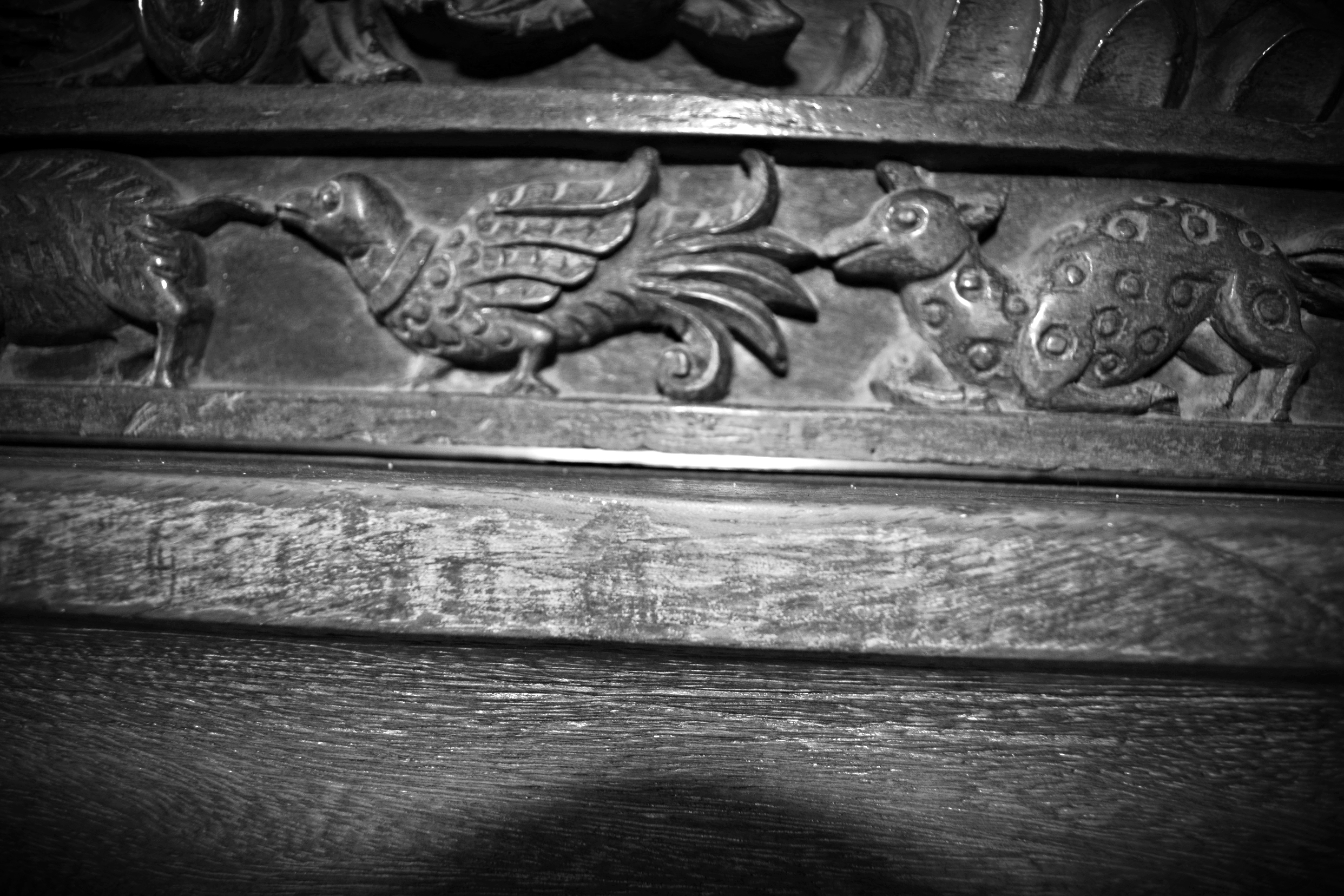One of the most fascinating aspects of the bed at Padmanabhapuram is the central motif on its head and footboards--a curious mix of European and Indian mythological elements. At the center, enclosed within a stylized ficus-leaf-shape, one finds a handsome serpent wound around a staff. The serpent around a staff is easily identified as the symbol of Asclepius, Greco-Roman god of medicine. (I have had discussions in the past with some scholars who thought differently, more on that here.) The serpent and staff are book-ended by a wide-winged eagle atop and a Kirttimukha (face of glory), both objects associated with protection and guardianship in Hindu visual culture.
(For a full set of photos of the palace in Padmanabhapuram, click here.)
Central emblem on the Padmanabhapuram bed
If you look closely, however, the staff itself is, curiously, not a staff. Rather, it is a cross (and a particular kind of cross at that) held at the bottom of its shaft by a pair of human hands (right above the kirttimukha's crown). The subtlety with which Christian and Hindu imagery were brought together for the specific purpose of blessing the king is striking indeed, however, in the type of cross depicted perhaps lies a clue to the identity of the school of artists who produced this bed.
It took me a couple of visits to the bed to notice the pair of hands holding the staff-cross. What struck me is that the way in which these hands hold the staff is particular: when we usually hold something like a stick or a staff we hold it with both our hands clasped in the same direction (figure 1 below). But the pair of hands seen on the headboard is clasped differently, like in figure 2. This is a specific way of holding something in front of you to hoist it up high as well as to balance its weight centrally for a longer period, like a banner that the leader of a band might hold, for example.
Left: Figure 1; Right: Figure 2
The formality of this gestures made me wonder: could it be that the pair of hands is holding something of honor in a procession, perhaps a processional cross?
Christianity practiced along the Malabar Coast was mainly Catholic in ritual although there were older Syriac Christians in Kerala from around 52CE. (For a really great introductory survey of Christianity in India until the early modern period, see Gillman/Klimkeit's Christians in Asia Before 1500 UMich Press, 1999.) Many of the Christian rituals on the Malabar Coast followed Catholic liturgical rites that included spectacular festivals and processions, that continues today. Processional crosses, much like Hindu temple processional idols, were carried in front of these processions.
Christian festival processions in Kerala
The processional staff-cross displayed on the headboard may help in identifying the center of production of the custom-made Padmanabhapuram bed. The bed was a gift to Maharaja Marthanda Varma, the ruler of Travancore, from either Portuguese or Dutch traders. (Thus far, no one has been able to concretely attribute the provenance of the bed to one or the other, and confusion reigns regarding its date of manufacture. More on dating woes here.)
My initial guess was that the bed was not produced in Travancore but brought from Fort Kochi (Cochin), the stronghold of Europeans on the Malabar Coast. (Fort Kochi was a safe haven for the Portuguese, and after they were ousted in 1663, it remained under the Dutch until 1795, when Holland ceded all its dominions in India to the British following William V's Kew Letters.) After all, why would the Europeans gift a powerful potentate of the region a bed, medicinal as it may be, from his own kingdom?? My hunch, I found, was supported in the essays of an early-twentieth-century Danish curator of Indian furniture, Wilhelm Slomann. His essays in Burlington Magazine from the 1920s mentioned, in passing, that an active trade center producing export-furniture existed in "Malabar". (I take this to mean Cochin because if it was the southern Malabar coast, Slomann would have addressed it as Travancore; Malabar in twentieth-century meant the British-controlled portions of Kerala to the north of Travancore.) Indeed, a bed that he claims as made in Southern India, looks, at least in basic organizational framework of its design, similar to the Padmanabhapuram bed.
My hunch has turned into a tentative argument with the analysis of the staff-cross. If you take a close look, you will see that the cross has two perpendicular prongs on top. The shorter prong above the longer one, connects the two upper ends of the stylized ficus-leaf frame that surrounds the serpent-wound cross. With no archival documents uncovered thus far (I hope to get hold of Dutch Malabar documents this Fall) it is hard to be absolutely sure, but I contend that the cross resembles the famous Coonan Cross of Mattancheri in Fort Kochi.
Coonan Cross holds special significance for the Malayalee Christians of central Kerala. It was in front of the cross of Our Lady of Life Church, in 1653, that the St. Thomas Christians of Kerala broke into two factions, one who accepted Latin rites brought in by Portuguese Jesuits, and the other, called Malankara Christians, returning to their older Syriac faith. For Malankara Christians, Coonan Cross where the oath was taken held special significance, and with time, it became a place of pilgrimage for local Christians from central Kerala.
Left: A contemporary depiction of the Oath of Coonan Cross; Right: Coonan Cross (identified as the original cross from 17th century) at the Chapel outside Our Lady of Life Church, Mattancheri, Kochi, Kerala
The staff-cross on Padmanabhapuram bed's headboard, I suggest, was based on the Coonan Cross from the distinct formation of this cross that is not seen elsewhere on the Malabar Coast. It leads me to make the claim that artists local to Mattancheri in Fort Kochi made the bed since the cross was peculiar to Mattancheri, even today. This would also make sense considering there were direct sea route and ships available from Fort Kochi to various ports in Travancore, by which the bed could have reached Padmanabhapuram.
Further research will tell us more but if this holds true, two things unknown thus far about Kochi society comes into play. First, various Christian denominations continued to work with one another, and if these artists were Malankara Christians, it could be possible that this denomination occupied the lower rung of society, since their Hindu counterparts were considered lower caste at this time. Second, the traditional understanding of the Kerala artist have placed him as categorically Hindu, working for the king and the temples. While we have known about export furniture business and furniture-making geared for the European markets from the works of scholars like Amin Jaffer, we do not have information about these people--who they were, how they worked, organized, and lived, or what strata of society they occupied. So I am looking forward to learning more about this artisanal class.
(May be time to approach Malankara churches for their internal records?!)
*If you have any information on this bed or beds similar to this one, drop me a line!






